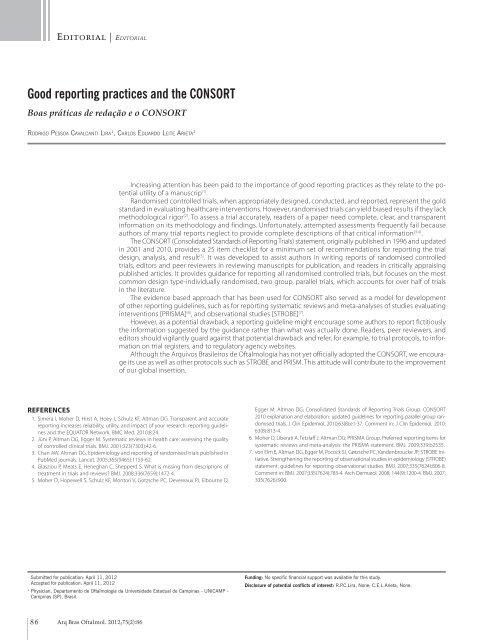São Paulo (SP) - Conselho Brasileiro de Oftalmologia
São Paulo (SP) - Conselho Brasileiro de Oftalmologia
São Paulo (SP) - Conselho Brasileiro de Oftalmologia
Create successful ePaper yourself
Turn your PDF publications into a flip-book with our unique Google optimized e-Paper software.
Editorial | Editorial<br />
Good reporting practices and the CONSORT<br />
Boas práticas <strong>de</strong> redação e o CONSORT<br />
Rodrigo Pessoa Cavalcanti Lira 1 , Carlos Eduardo Leite Arieta 1<br />
Increasing attention has been paid to the importance of good reporting practices as they relate to the po <br />
tential utility of a manuscrip (1) .<br />
Randomised controlled trials, when appropriately <strong>de</strong>signed, conducted, and reported, represent the gold<br />
standard in evaluating healthcare interventions. However, randomised trials can yield biased results if they lack<br />
methodological rigor (2) . To assess a trial accurately, rea<strong>de</strong>rs of a paper need complete, clear, and transparent<br />
information on its methodology and findings. Unfortunately, attempted assessments frequently fail because<br />
authors of many trial reports neglect to provi<strong>de</strong> complete <strong>de</strong>scriptions of that critical information (3,4) .<br />
The CONSORT (Consolidated Standards of Reporting Trials) statement, originally published in 1996 and updated<br />
in 2001 and 2010, provi<strong>de</strong>s a 25 item checklist for a minimum set of recommendations for reporting the trial<br />
<strong>de</strong>sign, analysis, and result (5) . It was <strong>de</strong>veloped to assist authors in writing reports of randomised controlled<br />
trials, editors and peer reviewers in reviewing manuscripts for publication, and rea<strong>de</strong>rs in critically appraising<br />
published articles. It provi<strong>de</strong>s guidance for reporting all randomised controlled trials, but focuses on the most<br />
common <strong>de</strong>sign type-individually randomised, two group, parallel trials, which accounts for over half of trials<br />
in the literature.<br />
The evi<strong>de</strong>nce based approach that has been used for CONSORT also served as a mo<strong>de</strong>l for <strong>de</strong>velopment<br />
of other reporting gui<strong>de</strong>lines, such as for reporting systematic reviews and meta-analyses of studies evaluating<br />
interventions [PRISMA] (6) , and observational studies [STROBE] (7) .<br />
However, as a potential drawback, a reporting gui<strong>de</strong>line might encourage some authors to report fictitiously<br />
the information suggested by the guidance rather than what was actually done. Rea<strong>de</strong>rs, peer reviewers, and<br />
editors should vigilantly guard against that potential drawback and refer, for example, to trial protocols, to information<br />
on trial registers, and to regulatory agency websites.<br />
Although the Arquivos <strong>Brasileiro</strong>s <strong>de</strong> <strong>Oftalmologia</strong> has not yet officially adopted the CONSORT, we encourage<br />
its use as well as other pro tocols such as STROBE and PRISM. This attitu<strong>de</strong> will contribute to the improvement<br />
of our global insertion.<br />
REFERENCES<br />
1. Simera I, Moher D, Hirst A, Hoey J, Schulz KF, Altman DG. Transparent and accurate<br />
reporting increases reliability, utility, and impact of your research: reporting gui<strong>de</strong>lines<br />
and the EQUATOR Network. BMC Med. 2010;8:24.<br />
2. Jüni P, Altman DG, Egger M. Systematic reviews in health care: assessing the quality<br />
of controlled clinical trials. BMJ. 2001;323(7303):42-6.<br />
3. Chan AW, Altman DG. Epi<strong>de</strong>miology and reporting of randomised trials published in<br />
PubMed journals. Lancet. 2005;365(9465):1159-62.<br />
4. Glasziou P, Meats E, Heneghan C, Shepperd S. What is missing from <strong>de</strong>scriptions of<br />
treat ment in trials and reviews? BMJ. 2008;336(7659):1472-4.<br />
5. Moher D, Hopewell S, Schulz KF, Montori V, Gotzsche PC, Devereaux PJ, Elbourne D,<br />
Egger M. Altman DG; Consolidated Standards of Reporting Trials Group. CONSORT<br />
2010 explanation and elaboration: updated gui<strong>de</strong>lines for reporting parallel group randomised<br />
trials. J Clin Epi<strong>de</strong>miol. 2010;63(8):e1-37. Comment in: J Clin Epi<strong>de</strong>miol. 2010:<br />
63(8):813-4.<br />
6. Moher D, Liberati A, Tetzlaff J, Altman DG; PRISMA Group. Preferred reporting items for<br />
systematic reviews and meta-analysis: the PRISMA statement. BMJ. 2009;339:b2535.<br />
7. von Elm E, Altman DG, Egger M, Pocock SJ, Gøtzsche PC, Van<strong>de</strong>nbroucke JP; STROBE Initiative.<br />
Strengthening the reporting of observational studies in epi<strong>de</strong>mio logy (STROBE)<br />
statement: gui<strong>de</strong>lines for reporting observational studies. BMJ. 2007;335(7624):806-8.<br />
Comment in: BMJ. 2007;335(7624):783-4. Arch Dermatol. 2008; 144(9):1200-4. BMJ. 2007;<br />
335(7626):900.<br />
Submitted for publication: April 11, 2012<br />
Accepted for publication: April 11, 2012<br />
1<br />
Physician, Departamento <strong>de</strong> <strong>Oftalmologia</strong> da Universida<strong>de</strong> Estadual <strong>de</strong> Campinas - UNICAMP -<br />
Campinas (<strong>SP</strong>), Brasil.<br />
Funding: No specific financial support was available for this study.<br />
Disclosure of potential conflicts of interest: R.P.C.Lira, None; C.E.L.Arieta, None.<br />
86 Arq Bras Oftalmol. 2012;75(2):86

















